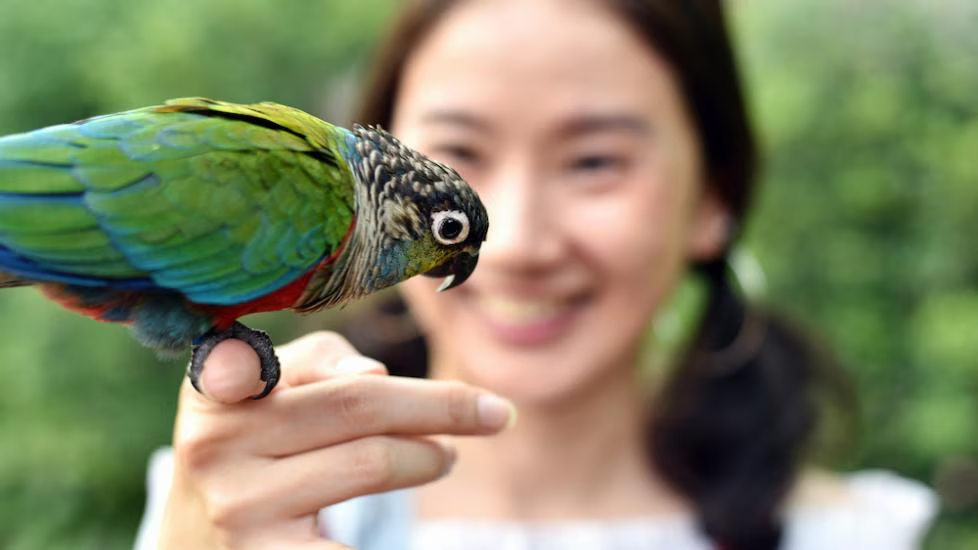Bringing a bird into your home is more than just acquiring a pet—it’s the beginning of a unique relationship with a fascinating, intelligent creature.
But unlike cats or dogs, birds don’t come pre-wired to trust humans. Building a bond with a bird takes time, patience, and an understanding of their body language and instincts.
Whether you’ve adopted a hand-raised parrot or a shy budgie from a pet store, training and taming are essential parts of making your feathered friend feel safe, happy, and engaged. In this article, we’ll explore how to build trust with your bird, teach them simple (and fun) tricks, and safely introduce leash training for more adventurous outings.
Step 1: Building Trust — The Foundation of All Training
Birds are prey animals by nature, which means their first instinct when confronted with the unknown is usually fear, not curiosity. This is especially true for birds that haven’t been hand-tamed or have had limited human interaction. Before you can think about training your bird to do tricks or wear a harness, you need to build a strong foundation of trust.
Start with presence, not pressure.
Sit near your bird’s cage and let them get used to your presence without trying to touch or handle them. Talk to them in a soft, calm voice. Over time, your bird will start to associate your presence with safety.
Use treats wisely.
Find out what your bird’s favorite treat is—whether it’s millet, sunflower seeds, or small pieces of fruit—and use it to reinforce positive interactions. Hold a treat through the bars of the cage, letting them come to you. This slow, reward-based approach can significantly reduce fear and build confidence.
Respect boundaries.
Avoid forcing interactions. Birds remember negative experiences, and being grabbed or chased can set back weeks of progress. If your bird backs away or fluffs up defensively, give them space.
Step 2: Step-Up Training — The First Trick That Builds Cooperation
Once your bird starts feeling comfortable taking treats from your hand, you can begin teaching one of the most useful and foundational commands: “Step up.”
This involves gently encouraging your bird to step onto your finger or hand when prompted. Here’s how to do it:
- Approach slowly, offering your hand or a perch horizontally.
- Say a consistent cue, like “step up” in a calm voice.
- Use gentle pressure against the bird’s lower chest (not the stomach) to prompt them to lift one foot.
- When they step on, reward immediately with praise and a treat.
- Repeat often, but end sessions on a positive note before your bird becomes tired or agitated.
This command lays the groundwork for more advanced training and also improves your bird’s cooperation during handling or vet visits.
Step 3: Teaching Fun Tricks — Mental Stimulation for a Happy Bird
Birds are incredibly intelligent, and many species (especially parrots) thrive on mental challenges. Once your bird is comfortable with you and has mastered basic handling, you can introduce fun and interactive tricks.
Some easy beginner tricks include:
- Turn around: Teach your bird to spin in a circle on a perch.
- Wave: Train them to lift one foot in a waving motion.
- Target training: Use a stick or pointer to guide them from perch to perch.
The key to success is positive reinforcement. Use a clicker or a consistent word (like “yes!”) followed by a treat when your bird performs the desired action. Keep training sessions short (5–10 minutes), and always end on a high note.
Over time, training becomes a form of enrichment for your bird—it keeps their mind active and deepens your bond.
Step 4: Leash Training — Exploring the Outdoors Safely
Many bird owners dream of letting their birds enjoy the fresh air and sunshine, but outdoor time must be approached with caution. That’s where leash training (using a bird harness) comes in.
Choose the right harness.
Bird harnesses are specially designed to be lightweight and secure. Never use a makeshift leash, and never attach anything to a bird’s legs or neck. Brands like Aviator make reputable options for small to large birds.
Desensitize before use.
Introduce the harness slowly. Leave it near your bird’s cage so they can explore it visually. Once they’re used to it, gently place it near their body for a few seconds, rewarding them with treats each time.
Practice indoors first.
Only after your bird is comfortable wearing the harness indoors should you attempt to go outside. Start in a quiet, controlled area like your backyard. Keep outings short and always be attentive to signs of stress or fatigue.
With consistency and patience, many birds learn to enjoy outdoor adventures safely.
Training Is a Journey, Not a Destination
Training and taming a bird isn’t a race—it’s a relationship. Progress might be slow at times, and setbacks are normal, especially if your bird has had traumatic experiences in the past. The key is to remain patient, stay consistent, and celebrate every small victory.
Remember: Every bird is different. While some may take to training quickly, others may need weeks or even months to feel comfortable stepping onto your hand. That’s okay. The trust you build through these daily interactions will be the foundation of a beautiful, lifelong friendship.
So take your time, speak softly, and train with kindness. Your bird isn’t just learning tricks—they’re learning to trust, connect, and thrive with you.




